
Mantua is a city and comune in Lombardy, Italy, and capital of the province of the same name.

Spoleto is an ancient city in the Italian province of Perugia in east-central Umbria on a foothill of the Apennines. It is 20 km (12 mi) S. of Trevi, 29 km (18 mi) N. of Terni, 63 km (39 mi) SE of Perugia; 212 km (132 mi) SE of Florence; and 126 km (78 mi) N of Rome.
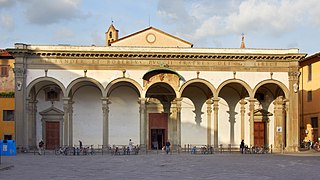
The Basilica della Santissima Annunziata is a Renaissance-style, Catholic minor basilica in Florence, region of Tuscany, Italy. This is considered the mother church of the Servite Order. It is located at the northeastern side of the Piazza Santissima Annunziata near the city center.

The Basilica Papale di San Lorenzo fuori le mura is a Roman Catholic Minor papal basilica and parish church, located in Rome, Italy. The Basilica is one of the Seven Pilgrim Churches of Rome and one of the five "papal basilicas", each of which was assigned to the care of a Latin Church patriarchate. The Basilica was assigned to the Patriarchate of Jerusalem. The Basilica is the shrine of the tomb of its namesake, Saint Lawrence, one of the first seven deacons of Rome who was martyred in 258. Many other saints and Bl. Pope Pius IX are also buried at the Basilica, which is the centre of a large and ancient burial complex.

Spello is an ancient town and comune (township) of Italy, in the province of Perugia in eastern-central Umbria, on the lower southern flank of Mt. Subasio. It is 6 km (4 mi) NNW of Foligno and 10 km (6 mi) SSE of Assisi.

Poggibonsi is a town in the province of Siena, Tuscany, central Italy. It is located on the river Elsa and is the main centre of the Valdelsa Valley.

The Minor Basilica of St. Lawrence in Damaso or simply San Lorenzo in Damaso is a parish and titular church in central Rome, Italy that is dedicated to St. Lawrence, deacon and martyr. It is incorporated into the Palazzo della Cancelleria, which enjoys the extraterritoriality of the Holy See.

The Palazzo Ducale di Mantova is a group of buildings in Mantua, Lombardy, northern Italy, built between the 14th and the 17th century mainly by the noble family of Gonzaga as their royal residence in the capital of their Duchy. The buildings are connected by corridors and galleries and are enriched by inner courts and wide gardens. The complex includes some 500 rooms and occupies an area of c. 34,000 m2, which make it the sixth largest palace in Europe after the palaces of the Vatican, the Louvre Palace, the Palace of Versailles, the Royal Palace of Caserta and the Castle of Fontainebleau. It has more than 500 rooms and contains 7 gardens and 8 courtyards. Although most famous for Mantegna's frescos in the Camera degli Sposi, they have many other very significant architectural and painted elements.

Piglio is a comune (municipality) in the Province of Frosinone in the Italian region Lazio, located about 50 kilometres (31 mi) east of Rome and about 30 kilometres (19 mi) northwest of Frosinone, offering a panoramic view on the valleys of the Sacco and Aniene rivers.

Genoa Cathedral or Metropolitan Cathedral of Saint Lawrence is a Roman Catholic cathedral in the Italian city of Genoa. It is dedicated to Saint Lawrence, and is the seat of the Archbishop of Genoa. The cathedral was consecrated by Pope Gelasius II in 1118 and was built between the twelfth century and the fourteenth century as fundamentally a medieval building, with some later additions. Secondary naves and side covers are of Romanesque style and the main facade is Gothic from the early thirteenth century, while capitals and columns with interior corridors date from the early fourteenth century. The bell tower and dome were built in the sixteenth century.
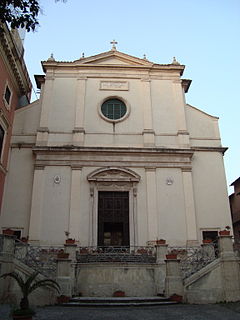
The church of San Lorenzo in Panisperna is a Roman Catholic church on Via Panisperna, Rome, central Italy. It was previously known as "San Lorenzo in Formoso". It was erected on the site of its dedicatee's martyrdom. It is one of several churches in Rome dedicated to him.
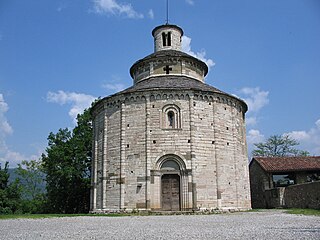
The Rotonda di San Tomè is a church in the comune (municipality) of Almenno San Bartolomeo, in the province of Bergamo, Lombardy, Northern Italy.
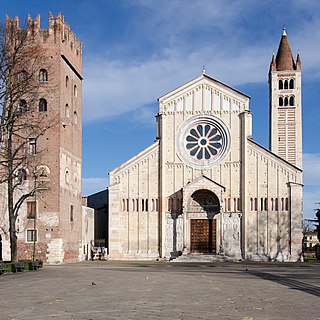
The Basilica di San Zeno is a minor basilica of Verona, northern Italy constructed between 967 and 1398 AD. Its fame rests partly on its Romanesque architecture and partly upon the tradition that its crypt was the place of the marriage of Shakespeare's Romeo and Juliet. It stands adjacent to a Benedictine abbey, both dedicated to St Zeno of Verona.

San Cristoforo sul Naviglio is a church in Milan, northern Italy.

The Basilica of San Giacomo Maggiore is an historic Roman Catholic church in Bologna, region of Emilia Romagna, Italy, serving a monastery of Augustinian friars. It was built starting in 1267 and houses, among the rest, the Bentivoglio Chapel, featuring numerous Renaissance artworks.

Treviso Cathedral is a Roman Catholic cathedral in Treviso, Veneto, northern Italy, dedicated to Saint Peter. It is the seat of the bishop of Treviso.

San Barnaba is a Roman Catholic church located at the intersection of Via Giovanni Chiassi and Via Carlo Poma in Mantua, Lombardy, Italy.
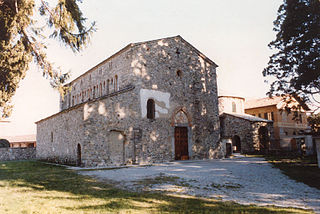
The Basilica di San Vincenzo is a church in Galliano, a frazione of Cantù, in Lombardy, northern Italy. An example of local Romanesque architecture, it was founded in 1007. The complex includes also a baptistry, dedicated to St. John the Baptist.

Avnede Church is a Gothic church located some 7 km (4.3 mi) southeast of Nakskov on the Danish island of Lolland. Frescos discovered on the chancel arch during repairs in 2009 are now being restored by the National Museum.

The Torre dell'Orologio is a 15th-century renaissance tower on the Piazza delle Erbe in Mantua, Italy. It is attached to the Palazzo della Ragione, and next to the Rotonda di San Lorenzo. It houses an astronomical clock.





















